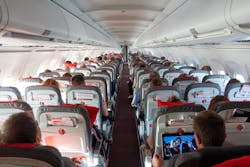In-flight connectivity players revisit questions about the business model vs demand
PARIS - Mobility, and in particular aviation, remains a key barometer for the satellite industry, as it looks to diversify its revenue streams away from video/broadcast. In-flight Connectivity (IFC) remains a key target market for many big players. The market was shaken up this year when Starlink announced a deal with Hawaiian Airlines, Mark Holmes reports for Aviation Today. Continue reading original article.
The Military & Aerospace Electronics take:
16 September 2022 - Tal Kalderon, head of In-Flight Entertainment & Connectivity at Israel's El Al Airlines says it is important that an airline has access to the best technology when it comes to IFC, even if replacing equipment means it is tricky to make decisions. “We must always make sure we are getting the best technology. So, previously it was Ka-band. Technology is progressing fast. We know it is a huge investment. We don’t see a choice. The demand is growing all the time,” he said. “We don’t know yet what future iterations of technology will look like. I don’t believe in the next few years, we will change the antennas or the hardware on board, as an example. But, if we find out, the technology isn’t providing what we want, we have SLAs with our providers. We need to ensure we have the best technologies.”
Related: Viasat tapped by Virgin Atlantic to provide in-flight connectivity for its new A330 fleet
Related: Embraer installs Ka-Band in Flexjet’s Legacy 500 fleet in Europe
Jamie Whitney, Associate Editor
Intelligent Aerospace
